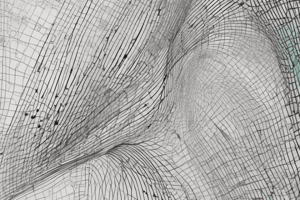Podcast
Questions and Answers
What is the domain of the function f(x) = √(x + 1)?
What is the domain of the function f(x) = √(x + 1)?
What is the domain of the function f(x) =
rac{1}{x-5}?
What is the domain of the function f(x) = rac{1}{x-5}?
What is the composition (g o f)(x) if f(x) = √(x - 1) and g(x) = 4x²?
What is the composition (g o f)(x) if f(x) = √(x - 1) and g(x) = 4x²?
What is the inverse function of f(x) = 3x - 6?
What is the inverse function of f(x) = 3x - 6?
Signup and view all the answers
What is the domain of the function f(x) = √(4 - x²)?
What is the domain of the function f(x) = √(4 - x²)?
Signup and view all the answers
Study Notes
Finding the Domain of a Function
- Determine the input values (x-values) for which the function is defined.
- Exclude values that result in division by zero or the square root of a negative number.
- The domain is the set of all possible input values.
Function Composition
- Substitute the expression of one function into another function.
- The composition of functions f(g(x)) involves plugging the expression of g(x) into f(x).
Finding the Inverse Function
- Switch the roles of x and y (input and output values).
- Solve for y (the inverse function).
- The inverse function reverses the original function's transformation of input values.
Verifying f(f⁻¹(x)) = x
- Substitute the inverse function into the original function.
- Simplify the expression to show it equals x.
- This confirms that the inverse function reverses the effects of the original function.
Studying That Suits You
Use AI to generate personalized quizzes and flashcards to suit your learning preferences.
Description
Test your understanding of functions in Algebra Class 10! This quiz covers finding the domain of a function, composing functions, and determining inverse functions. Additionally, you'll verify the relationship between a function and its inverse.




